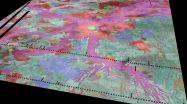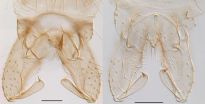Study suggests active volcanism on Venus
2015-06-18
(Press-News.org) PROVIDENCE, R.I. [Brown University] -- An international team of scientists has found some of the best evidence yet that Venus, Earth's nearest neighbor, is volcanically active.
In combing through data from the European Space Agency's Venus Express mission, the scientists found transient spikes in temperature at several spots on the planet's surface. The hotspots, which were found to flash and fade over the course of just a few days, appear to be generated by active flows of lava on the surface.
"We were able to show strong evidence that Venus is volcanically, and thus internally, active today," said James W. Head, a geologist at Brown University and co-author of a paper describing the new research. "This is a major finding that helps us understand the evolution of planets like our own."
The research is published online in Geophysical Research Letters.
The hotspots turned up in thermal imaging taken by the Venus Express spacecraft's Venus Monitoring Camera. The data showed spikes in temperature of several hundred degrees Fahrenheit in spots ranging in size from 1 square kilometer to over 200 kilometers.
The spots were clustered in a large rift zone called Ganiki Chasma. Rift zones are formed by stretching of the crust by internal forces and hot magma that rises toward the surface. Head and Russian colleague Mikhail Ivanov had previously mapped the region as part of a global geologic map of Venus generated from the Soviet Venera missions in the 1980s and U.S. Magellan mission in the 1990s. The mapping work had shown that Ganiki Chasma was quite young, geologically speaking, but just how young wasn't clear until now.
"We knew that Ganiki Chasma was the result of volcanism that had occurred fairly recently in geological terms, but we didn't know if it formed yesterday or was a billion years old," Head said. "The active anomalies detected by Venus Express fall exactly where we had mapped these relatively young deposits and suggest ongoing activity."
The latest finding is consistent with other data from Venus Express that have hinted at very recent volcanic activity. In 2010, infrared imaging from several volcanoes seemed to indicate lava flows from thousands to a few million years old. A few years later, scientists reported transient spikes in sulfur dioxide in Venus' upper atmosphere, another potential signal of active volcanism.
The observation of hotspots by Venus Express, combined with the geologic mapping from Venera and Magellan, make a strong case for a volcanically active Venus, Head says.
"This discovery fits nicely with the emerging picture of very recent activity in Venus' geologic history," he said. "These remarkable findings were the result of collaborations spanning many years and many political borders. They underscore the importance of international collaboration in exploring our solar system and understanding how it evolves."
INFORMATION:
The work was led by Eugene Shalygin and Wojciech Markiewicz of the Max Planck Institute. Additional co-authors were Alexander Basilevski (Russia's Vernadsky Institute and Brown University), Dima Titov (European Space Agency) and N.I. Ignatiev (Russia's Space Research Institute).
[Attachments] See images for this press release:

ELSE PRESS RELEASES FROM THIS DATE:
2015-06-18
Currently, there are more than 350 million type 2 diabetics and according to the World Health Organization (WHO) by 2030 it will be the 7th leading cause of death worldwide.
The hallmark of type 2 diabetes is insulin resistance, which is initially compensated for by an increase in beta cell size (responsible for producing insulin). However, the beta cells of such patients will eventually collapse and die, leading to full blown type 2 diabetes.
Researchers from the Laboratory of Cancer Metabolism at IDIBELL, led by Sara Kozma, have shown in animal models that inhibition ...
2015-06-18
NEW YORK (June 18, 2015) - Proper laundering and handling are important in achieving and maintaining the hygienically-clean quality of healthcare fabrics and textiles delivered to the point of care, according to a new review that highlights evidence-based strategies to inhibit potentially serious contamination. The review, based on findings and recommendations from peer-reviewed studies, as well as current standards and guidelines, is published online in Infection Control & Hospital Epidemiology, the journal of the Society for Healthcare Epidemiology of America (SHEA). ...
2015-06-18
Over 35 million people worldwide are currently infected by HIV. Antiviral therapies can keep the virus from multiplying. However, no drug can cure infection so far, because various cell types continue to carry the virus in a latent, i.e. quiescent, state. Scientists of Helmholtz Zentrum Muenchen have now established a model for latent HIV infection of brain cells. The researchers used this model to identify various compounds that affect latency of the virus in the brain. This study was published in the journal AIDS.
"Chronic infection is caused by long-lived cells with ...
2015-06-18
Revisiting original types and DNA analysis exposed hidden diversity in minute non-biting midges. Two species new to science were discovered and one misapprehended species was removed by following the traces back to the source in Brussels. The study was published in the open access journal ZooKeys.
"Nobody suspected a mystery until we solved it", says Elisabeth Stur, the senior author of the paper describing the misconception. - "Maybe even some will be upset that we discovered this long lasting misidentification".
It all started with Elisabeth Stur and Torbjørn ...
2015-06-18
Scientists at the University of Southampton think that Next-Generation Sequencing (NGS) of invasive organisms holds the key to furthering our understanding of ecological and evolutionary processes.
In a review of recent studies published in Current Zoology, the researchers say the technique is underutilised in the field of invasion biology. They believe NGS has the potential to transform our understanding of why non-native species adapt and thrive in new environments, often at the expense of their indigenous competitors.
The key to the success of biological invasions ...
2015-06-18
New research conducted by archaeologists from the University of York and the Universitat Autònoma de Barcelona, in collaboration with members of Tel Aviv University, reveals striking insights into the living conditions and dietary choices of those who lived during the Middle Pleistocene some 300,000 - 400,000 years ago.
The article, published in Quaternary International, describes the study in which samples of plaque were extracted from the teeth of three Lower Palaeolithic hominins who lived in Qesem Cave, Israel.
Conducting optical and chemical analyses on the ...
2015-06-18
BUFFALO, N.Y. -- Researchers at the University at Buffalo have discovered a previously unknown neural pathway that can regulate changes made in the brain due to cocaine use, providing new insight into the molecular basis of cocaine addiction.
"Addiction is a life-long affliction manifested by episodes of relapse, despite prolonged abstinence," says Amy Gancarz, PhD, lead author of the study, which was published on June 1 in an Advance Online Publication in Nature Neuroscience. "There is a need to more fully understand the long-term molecular changes in the brain involved ...
2015-06-18
This new NASA/ESA Hubble Space Telescope image shows a gathering of four cosmic companions. This quartet forms part of a group of galaxies known as the Hickson Compact Group 16, or HCG 16 -- a galaxy group bursting with dramatic star formation, tidal tails, galactic mergers and black holes.
This quartet is composed of (from left to right) NGC 839, NGC 838, NGC 835, and NGC 833 -- four of the seven galaxies that make up the entire group. They shine brightly with their glowing golden centres and wispy tails of gas [1], set against a background dotted with much more distant ...
2015-06-18
A new study led by Vanderbilt University Medical Center investigators found new diagnoses of prostate cancer in the U.S. declined 28 percent in the year following the draft recommendation from the United States Preventive Services Task Force (USPSTF) against routine PSA screening for men. The new research, led by first author Daniel Barocas, M.D., MPH, assistant professor of urological surgery and medicine, was posted online in the June 15 issue of The Journal of Urology in advance of publication.
In October 2011, the USPSTF issued a draft guideline discouraging ...
2015-06-18
Researchers at Monash University have found physical differences in the brains of people who respond emotionally to others' feelings, compared to those who respond more rationally, in a study published in the journal NeuroImage.
The work, led by Robert Eres from the University's School of Psychological Sciences, pinpointed correlations between grey matter density and cognitive and affective empathy. The study looked at whether people who have more brain cells in certain areas of the brain are better at different types of empathy.
"People who are high on affective empathy ...
LAST 30 PRESS RELEASES:
[Press-News.org] Study suggests active volcanism on Venus


